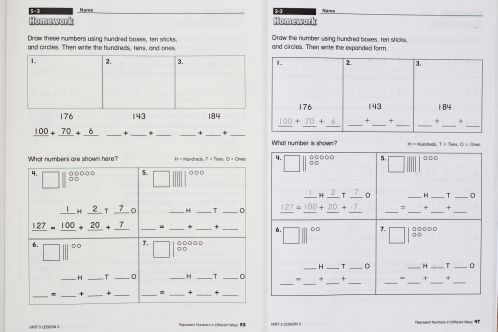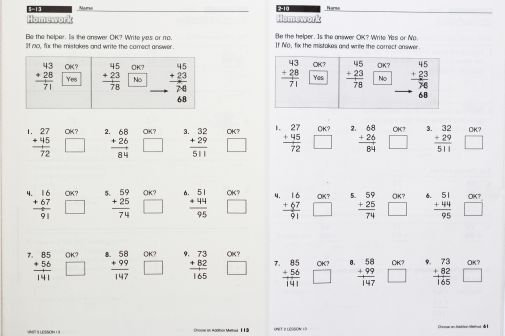
A recent study found that number sense in infants is a predictor of how well they later learn the symbolic math typically taught in school. Researchers observed how long 6-month-old infants looked at a screen with a changing number of dots compared with how long they looked at a screen with a constant number of dots in changing patterns. (See video above.) Three years later, these children were given an IQ test and several types of math tests. The infants who looked longer at the screen with a changing number of dots, which is indicative of stronger number sense, subsequently scored higher on the math tests, regardless of IQ. So what is "number sense," and does this mean that parents should start packing dotted flash cards in the diaper bag?
What is Number Sense?
There are different definitions of number sense, but they generally agree on a few basic factors:
• Number sense is intuitive. In other words it is not arrived at through conscious reasoning.
• Number sense includes an understanding of magnitude of amounts, relationships between amounts, and how amounts change through natural actions.
Examples of number sense in an infant might include observing and understanding the following: There are a lot of stars on my blanket. Daddy has more food on his plate than Mommy. I have a bunch of blocks on my high chair table. If I knock some off, I have fewer blocks. From what current science tells us, pre-verbal infants cannot actually have these words running through their heads. Nonetheless, a primitive understanding is there as humans seem to be born with an innate ability to perceive quantity before they can speak about it and well before they can write about it.
Nurturing Number Sense
So should you start showing your baby flash cards with dots? No. While the study’s authors hope that their findings will lead to improved strategies for math education, they are careful to caution that "[O]ur infant task only explains a small percentage of the variance in young children’s math performance. But our findings suggest that there is cognitive overlap between primitive number sense and symbolic math. These are fundamental building blocks."
Still, we know that there are benefits to talking to your baby as an essential part of the early learning process. It’s not unusual to hear a mother carrying on a one-sided conversation in which she emphasizes the phonetic sounds in the names of everyday objects. For example, "This is a banana. Buh buh banana." The baby eventually catches on that the "buh" sound is associated with a banana, and that Mom’s lips do this strange "roll in-then-pop out" motion when she makes this sound. This happens before the baby ever learns to say "banana" or that there is this symbol we call the letter "b" that represents this sound. When the letter "b" is finally introduced, children can connect it back to the "buh" sound and objects such as a banana to which they were introduced in infancy.
But how frequently do you notice a parent holding up two different bananas and talk about which one is bigger, or which one has more brown dots? Or what happens to a bunch of bananas when you pull one off? Or when you cut that banana into pieces? The study’s lead author indicates that "We believe that when children learn the meaning of number words and symbols, they’re likely mapping those meanings onto pre-verbal representations of number that they already have in infancy." If she is correct then adding number sense talk to those parent-baby conversations makes, well, sense!
The new school year is now a month old. By this time, most children who attend a public K-12 school in the US will have experienced the new Common Core State Standards in Mathematics (CCSSM). On the one hand, IMACS is pleased to see that key elements of the teaching philosophy we have lived by for more than 20 years are reflected in the Common Core Standards for Mathematical Practice. For a variety of reasons, however, we maintain a healthy amount of skepticism about whether the implementation of the CCSSM will lead to meaningful, positive change in mathematics education, particularly for our most talented youth.
Common Core Was Not Designed for Gifted Kids
First, the CCSSM was not designed with exceptional kids in mind. The official Common Core Web site states plainly that:
“The Standards set grade-specific standards but do not define the intervention methods or materials necessary to support students who are well below or well above grade-level expectations.”
[Source: https://www.corestandards.org/Math]
The Web site further acknowledges that Common Core, like its predecessors, cannot adequately address the unique needs of individual learners:
“No set of grade-specific standards can fully reflect the great variety in abilities, needs, learning rates, and achievement levels of students in any given classroom.”
[Source: https://www.corestandards.org/Math]
As to what educators should do about serving the diverse needs of a student body, Common Core guidance leaves them with unresolved internal conflict, offering both:
(i) “Learning opportunities will continue to vary across schools and school systems, and educators should make every effort to meet the needs of individual students based on their current understanding.”
[Source: https://www.corestandards.org/Math/Content/introduction/how-to-read-the-grade-level-standards]
and
(ii) “The Standards should be read as allowing for the widest possible range of students to participate fully from the outset, along with appropriate accommodations to ensure maximum participaton (sic) of students with special education needs.”
[Source: https://www.corestandards.org/Math]
[Note that Common Core does not include gifted children as an example of “students with special education needs.”]
But children in the right-hand tail of the distribution do have special education needs. Whether due to a failure to understand this fact, budgetary pressure, or some other constraint, some school districts seem to be latching on to (ii) above, using the arrival of Common Core as a reason to reduce or eliminate services or accommodations for gifted students. Should this become a national trend in education policy, our country will surely suffer as the majority of gifted children who rely on public education are left without appropriate alternatives.
What About Creative Problem Solvers?
Notwithstanding the potential for improving the thinking skills of typical students, the CCSSM are simply not built to inspire or nurture the creative problem solver. The unfortunate embracing of computerized testing as a cheap means of measuring “learning” — consequently resulting in a culture of teaching to the test — has made the K-12 classroom a place to dread for many unique thinkers. The plan to continue use of computerized testing under the new standards suggests that the non-standard thinker may still be out of place in the Common Core classroom.
IMACS recently asked Gerald R. Rising, SUNY Distinguished Teaching Professor Emeritus at the University at Buffalo, how he thought the CCSSM would affect mathematics education for bright children, to which he replied, “Any imposed curriculum can have a depressing effect on special programs for gifted students.” He also shared the following anecdote about the limits of standardized testing:
“On one of the tests appeared the trivial-sounding question that went something like this: ‘A workman seeks to pass a 20-foot long board through an opening with rectangular 6-foot by 8-foot cross-section. What is the maximum width of the board that is possible?’ The answer choices were: 8 feet, 9 feet, 10 feet and 11 feet. Several of our students answered 9 feet, because the board would necessarily have some thickness that would prevent a 10-foot wide board from passing through the opening. They lost full credit for thinking that was perfectly reasonable but that did not fit the professional test constructor’s overly simplistic model.”
IMACS has been delivering courses and administering tests online to bright and creative children for over 15 years, so we know a thing or two about designing effective computerized assessments of high-level thinking skills. Let’s just say that it takes tremendous creativity, foresight, and a deep understanding of how to leverage the power of technology. If high-stakes testing is here to stay, as it appears to be, we sincerely hope that the consortia working on Common Core-aligned assessments will find ways to reward (or at least not penalize) creative problem solvers.
Inadequate Investment in Training
Common Core marks a major change in teaching philosophy for math education in the US. The intent is to move away from just teaching procedural skills by giving equal weight to conceptual understanding. Teaching math with an emphasis on thinking and understanding, however, is not something one becomes proficient in after a few hours of training, which is all that many districts have provided to their teachers.
Such a radical shift in mindset can be especially challenging for some who have taught math with a completely different focus for many, many years. This is not to say that teachers are incapable of learning to teach a new way — quite the contrary. But, as with any field undergoing fundamental change, extensive training and professional development are necessary if districts and schools want a successful implementation of Common Core. So far, the evidence suggests that they cannot or will not be making that investment.
“Common Core” Textbooks In Name Only
Many of the textbooks currently on the market that say they are aligned to the Common Core standards were developed before the creation of the CCSSM. Note the example below of pages from old and new versions of a math text currently being used in California. The pages on the left were from the edition published in 2009, the year before states began adopting the CCSSM. The pages on the right are from the current edition that proclaims “Common Core” on the cover. (Click on an image to enlarge.)
Furthermore, such textbooks often only align to the specific content skills listed in the CCSSM rather than subscribing to the overall philosophy of the CCSSM. Many that claim to be aligned to the CCSSM do not include problems or tasks that involve the higher-level thinking skills that are supposed to be measured by the new Common Core standardized tests being developed.
Awareness and Advocacy Are More Important Now Than Ever
What does all this mean if you are the parent of a talented child? Probably more work for you. Just over a month ago, nearly two-thirds of respondents to a poll on education said they had never even heard of Common Core! So, if you’re thinking that someone else will speak up first, don’t count on it. Advocacy for a gifted student has never been easy given the lack of awareness and amount of misinformation about their unique educational needs. With the potential for Common Core to bring more harm than good to the education of exceptionally bright kids, it is more important now than ever to be heard.











